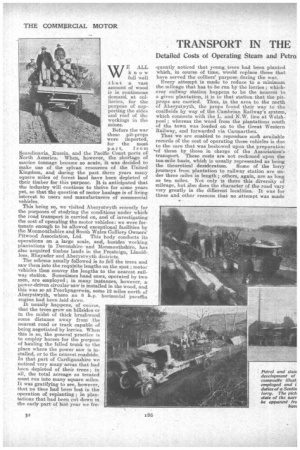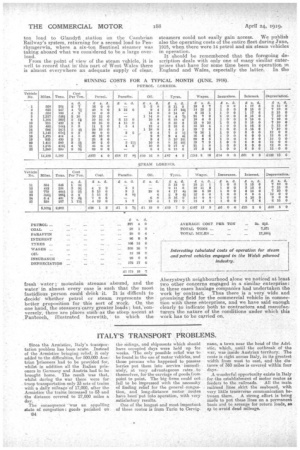TRANSPORT IN THE
Page 10

Page 11

Page 12

If you've noticed an error in this article please click here to report it so we can fix it.
PIT WOOD INDUSTRY.
Detailed Costs of Operating Steam and Petro he War-developed Home-grown Timber Trade.
E ALL know full well that a vast amount of wood is in continuous demand, at collieries, for the purpose of supporting the sides and roof of the workings in the mines.
Before the war these ,pit-props were imported, ' for the most part, from Scandinavia, Russia, and the Pacific, Coast ports of North America. When, however, the shortage of marine tonnage became so acute, it was decided to make use of the sylvan resources of the United Kingdom, and during the past three years many square miles of forest land have been depleted of their timber for this purpose. It is anticipated that the industry will continue to thrive for some years yet, so that the question of motor haulage is of living interest to users and manufacturers of commercial vehicles.
This being so, we visited Aberystwyth recently for the purposes of studying the conditions under which the road transport is carried on, and of investigating the cost of operating the motor vehicles : we were fortunate enough to be allowed exceptional facilities by the Monmouthshire and South Wales Colliery Owners' Pitwood Association, Ltd. This body conducts its operations on a. large scale, and, besides working plantations in Devonshire and Monmouthshire, has also acquired timber lands in the Presteign, Rhayader and Aberystwyth districts.
The scheme usually followed is to fell the trees and saw them into the requisite lengths on the spot ; motor vehicles then convey the lengths to the nearest railway station. Sometimes hand saws, operated by two men, are employed; in many instances, however, a power-driven circularsaw is installed in the wood, and this was so at Penrhyngerwin, some 12 miles north of Aberystwyth, where an 8 h.p. horizonial paraffin engine had been laid clown.
It usually happens, of course, that the trees grow on hillsides or in the midst of thick brushwood some distance away from the nearest road or track capable of being negotiated by lorries. When this is so, the general practice is to employ horses for the purpose of hauling the felled trunk to the place where the power saw is installed, or to the nearest roadside. In that part of Cardiganshire we noticed very many areas that had been depleted of their trees; in all, the total acreage so treated must run into many square miles. It was gratifying to see, however, that no time had been lost in the operation of replanting ; in plantations that had been cut down in the early part of lu,st year we Ire ,quently noticed that young„trees had been planted which, in course of time, would replace those that have served the colliers' purpose during the war.
Every attempt is made to reduce to a minimum the mileage that has to be run by the lorries ; whichever railway station happens to be the nearest to a given plantation, it is to that station that the pitprops are carried. Thus, in the area to the north of Aberystwyth, the props found their way to the coalfields by way of the Cambrian Railway's system, which connects with the L. and N.W. line at Welshpool ; whereas the wood from the plantations south of the town was loaded on to the Great Western Railway, and forwarded via Carmarthen.
That we are enabled to reproduce such available records of the cost of operating these vehicles is due to the care that was bestowed upon the preparation of these by those in charge of the Association's transport. These costs are not reckoned upon the ton-mile basis, which is usually represented as being the theoretical desideratum. Some of the lorry journeys from plantation to railway station are under three miles in length ; others, again, are as long as ten miles. Not only is there this diversity of mileage, but Aso does the character of the road vary very greatly in the different localities. It was for these and other reasons that no attempt was made to use the ton-mile basis ; instead, careful and systematized work was undertaken in order to show the Colliery Owners' Association exactly how much. per ton of pit-props, ought to be charged against the transport system. This met the needs of the Association; and we venture to think that the figures we are reproducing will be of yery great interest to our readers.
We are enabled to investigate the working costs of a typical Sentinel steamer and of a 5-ton PierceArrow over a period of one month. Considering the former, we found that in July, 1918—quite a typical month—this 6-ton Sentinel covered 952 miles in 54 journeys, carrying 312 tons of pit props. It used 77 cwt. of coal costing £5 12s.; it consumed oil and grease to the value of 16s. In that month, also, the driver's wages amounted to 221 14s. 10d., of which 28 13s. 5d. was in respect of overtime. Why the' wages came to so much was due to there being five pay-days in that month. Although, no• maintenance charges (i.e., costs for spares ansl fitter's wages in workshop) were incurred during flat month, the sum of 32s. was charged in respect of fitter's wages, this being due to certain workshop operations being divided equally among all of the lorries. Where, for example, fitter's wages have to be paid for laying down tools or repairing plant, this charge is quite fair ; at the same time, we think that it should be apportioned among the lorries proportionately to their first tost, and not equally per lorry.
The total of the above costs amounts to 228 ,2s. 10d. To this were added, for tyre depre: eiatiort 27 18s. 8d.; for lorry depreciation £7 10s. ; for insurance El ; for interest (at 5 per cent.) 23 15s. ; bringing a grand total of 249 18s. 6d. for operation expenses. Thus the cost per ton of pit-props hauled was 3s. 2d., and the coal consumption 1 cwt. per 12.38 miles.
In the case of the Pierce-Arrow, during March, 1918, this vehicle covered 747 miles in 83 journeys, and carried 426tons of pit-props. It consumed 126 gallons of petrol costing £18 18s., an.d used two pints of paraffin costing 3s. 2d., and three-and-a-half gallons of oil costing 9s. 4d. The driver's wages amounted to £16 16s. 10d. The total of these costs amounted to 236 Is. 4d., to which were added, for depreciation of tyres £4 13s. 4d. ; for depreciation of lorry 212 ; for insurance 21 ; for interest (at 5 per cent.) £6 giving in all a total operating expense of 260 Os. Sid. Thus, the cost per ton was 2s. sa. and the petrol consumption 1 gallon per 5.9 miles.
Working from Aberystwyth as centre, where there is a commodious garage and repair shop, this fleet operates numerous woods in the district. At present the Association's transport comprises only six petrol and three steam vehicles, the remainder having been transferred recently te some of the localities mentioned above. Leaving Aberystwyth at seven in the morning, we rode on a five-ton Pierce-Arrow lorry and took the northward direction, passing through a typical Welsh village, rejoicing—inappropriately enough —in the name of Bow Street. In this neighbourhood the scenery is of the grandest description, the snowcapped mountain masses of Plynlymon and Cader Idris towering in the background, above the wide • estuary of the Dovey. In such • mountainous country it is only to be expected that there should be some terrific; gradients: in our illustrations may be seen the narrow lane which, leaving the main road at Talyhont, winds up the steep hillside to where we took aboard our first load. The pictures portray the nature of some of the lanes that have to be negotiated ; it will be seen that the ruts are in some cases so deep that the axles are almost touching • the ground. In work of this kind road clearance is an important • point.
From Pantcoch the Pierce Arrow proceeded with a full five ton load to Glandyfi station on the Cambrian Railway's system, returning for a second load to Penrhyngerwin, where a six-ton Sentinel steamer was taking aboard what we considered to be a large overload.
From the point of view of the steam vehicle, it is well to record that in this part of West Wales there is almost everywhere an adequate supply of clear,
fresh water; mountain streams abound, and the water' in almost every case is such that the most fastidious person could drink it. It is difficult to decide whether petrol or steam represents the better proposition for this sort of work. On the one hand, the steamers carry greater loads; but, conversely, there are places such as the stleep ascent at
• Pantcoch, illustrated herewith, to which the
steamers could not easily gain access. We publish also the operating costs of the entire fleet during June, 1918, when there were 14 petrol and six steam vehicles in. operation.
It should be remembered that the foregoing description deals with only one of many similar enterprises that have for some time been in operation in England and Wales, especially the latter. In the Aberystwyth neighbourhood alone we noticed at least two other concerns engaged in a similar enterprise: in these cases haulage companies had undertaken the work by contract. Thus there is a very wide and promising field for the commercial vehicle in connection with these enterprises, and we have said enough clearly to indicate both to contractors and manufacturers the nature of the conditions under which this work has to be carried on.






















